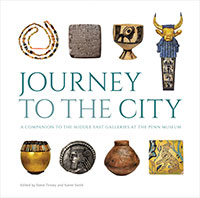
Journey to the City:
A Companion to the Middle East Galleries at the Penn Museum
The Penn Museum has a long and storied history of research and archaeological exploration in the ancient Middle East. This book highlights this rich depth of knowledge while also serving as a companion volume to the Museum's signature Middle East Galleries opening in April 2018. This edited volume includes chapters and integrated short, focused pieces from Museum curators and staff actively involved in the detailed planning of the new galleries. In addition to highlighting the most remarkable and interesting objects in the Museum's extraordinary Middle East collections, this volume illuminates the primary themes within these galleries (make, settle, connect, organize, and believe) and provides a larger context within which to understand them.
The ancient Middle East is home to the first urban settlements in human history, dating to the fourth millennium BCE; therefore, tracing this move toward city life figures prominently in the book. The topic of urbanization, how it came about and how these early steps still impact our daily lives, is explored from regional and localized perspectives, bringing us from Mesopotamia (Ur, Uruk, and Nippur) to Islamic and Persianate cites (Rayy and Isfahan) and, finally, connecting back to life in modern Philadelphia. Through examination of topics such as landscape, resources, trade, religious belief and burial practices, daily life, and nomads, this very important human journey is investigated both broadly and with specific case studies.
Steve Tinney is Associate Curator-in-Charge of the Babylonian Section and the Clark Research Associate Professor of Assyriology at the University of Pennsylvania.
Karen Sonik is Assistant Professor of Art History at Auburn University.
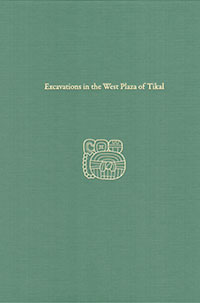
Excavations in the West Plaza of Tikal. Tikal Report 17
This volume reports on excavations carried out by Peter D. Harrison in the early 1960s in the West Plaza of the Maya center of Tikal, Guatemala. Primarily descriptive in nature, this work is an important compliment to Tikal Report No. 14: Excavations in the Great Plaza, North Terrace, and North Acropolis of Tikal, by William R. Coe. The West Plaza was originally the western portion of the Great Plaza until construction of Great Temple II separated it. Subsequently, the West Plaza took on its own identity.
This report presents data from these investigations no longer retrievable in the field and, therefore, of importance to anyone interested in the development of Tikal's epicenter.
William A. Haviland is Professor Emeritus of Anthropology at the University of Vermont. His original archaeological research in Guatemala has been the basis of numerous publications, including an earlier technical volume from the University of Pennsylvania Museum of Archaeology and Anthropology, Excavations in Small Residential Groups of Tikal, Groups 4F-1 and 4F-2: Tikal Report 19.
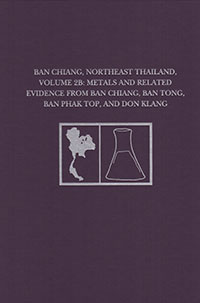
Ban Chiang, Northeast Thailand, Volume 2B:
Metals and Related Evidence from Ban Chiang, Ban Tong, Ban Phak Top, and Don Klang
The foundation of any archaeometallurgical study is study of excavated assemblages of metals and related remains. This volume presents in detail how the metals and remains such as crucibles excavated from four sites in northeast Thailand have been studied to understand the place of metal objects and technology in the ancient past of this region. In addition to typological examination, hundreds of technical analyses reveal the technological capabilities, preferences, and styles of metal artifact manufacturers in this part of Thailand. Detailed examination of contexts of recovery of metal remains employing a “life history” approach indicates that metal objects in those societies were used primarily in daily life, and only occasionally as grave goods. The most surprising find is that casting of copper-base artifacts to final form took place at all these village sites during the metal age period, indicating a decentralized final production stage that may prove to be unusual for metal age societies. These insights are made possible by applying the methods and theories introduced in the first volume of the suite of volumes that study the metal remains from Ban Chiang in regional contest.
Joyce C. White is the Executive Director of the Institute for Southeast Asian Archaeology.
Elizabeth G. Hamilton is the archaeometallurgist and data manager for the Institute for Southeast Asian Archaeology.
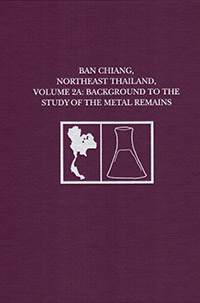
Ban Chiang, Northeast Thailand, Volume 2A Background to the Study of the Metal Remains
The emergence and adoption of metallurgy is one of the seminal topics of investigation in the history of archaeology, particularly in the history of archaeological research in Southeast Asia. The site of Ban Chiang, Thailand, is a central site in debates surrounding the chronology and significance of early metallurgy in the region. This book is the first in a series of four volumes that review the contributions of Ban Chiang and three related sites in northeast Thailand excavated by the Penn Museum to an understanding early metallurgy in Thailand.
As the study of archaeometallurgy is a complex topic that draws on numerous technical and social science disciplines, this introductory volume presents in several chapters the background needed to assess the metal and related evidence presented in the subsequent volumes in this series. A history of perspectives on the role of metals in ancient societies generally and Southeast Asia, specifically, is provided. Other chapters debunk the conventional paradigm for understanding metals and society and provide current theoretical perspectives and new paradigms for the study of ancient metals. The geological basis for the presence and location of metal ore resources in the region is reviewed. The final chapter presents a technical overview of ways material properties of ancient metals may be studied. While providing a background to the study of metals at Ban Chiang, the volume also reviews, synthesizes, and repositions the method and theory for the study of archaeometallurgy generally.
Joyce C. White is the Executive Director of the Institute for Southeast Asian Archaeology.
Elizabeth G. Hamilton is the archaeometallurgist and data manager for the Institute for Southeast Asian Archaeology.

Miscellaneous Investigations in Central Tikal-Structures in and around the Lost World Plaza Tikal
Tikal Report 23D
The Great Maya center of Tikal, in Guatemala, is famous for its well-preserved architecture. This book presents descriptions of six structures that belong to the Tikal Project category "standing architecture," that is, though partially collapsed, some features of these buildings remain in place and accessible without excavation. These structures were surveyed with little or no excavation as part of the Tikal Project Standing Architecture Survey. This report is the primary record of these structures in Tikal's urban land-scape, and it provides clear, precise, and usable architectural analyses for Mayanists, archaeologists, art historians, architectural historians, urbanists, and those interested in construction techniques and in the uses of Maya buildings.
H. Stanley Loten is Architect and Distinguished Research Professor at Carleton University.

Miscellaneous Investigations in Central Tikal-The Plaza of the Seven Temples
Tikal Report 23C
The Great Maya center of Tikal, in Guatemala, is famous for its well-preserved architecture. This book presents descriptions of nine structures that line the Plaza of the Seven Temples, which sits immediately west of the South Acropolis of Central Tikal. These structures were surveyed with little or no excavation as part of the Tikal Project Standing Architecture Survey. This report is the primary record of these structures in Tikal's urban landscape, and it provides clear, precise, and usable architectural analyses for Mayanists, archaeologists, art historians, architectural historians, urbanists, and those interested in construction techniques and in the uses of Maya buildings.
H. Stanley Loten is Architect and Distinguished Research Professor at Carleton University.

Miscellaneous Investigations in Central Tikal:
Great Temples III, IV, V, and VI, Tikal Report 23B
The Great Maya center of Tikal in Guatemala is famous for its well-preserved architecture. This book presents detailed descriptions of four of the six Great Temples that dominate Tikal’s city center. Whereas Great Temples I and II were published in 1990 in Tikal Report 14, the four structures presented here are Great Temples III, IV, V, and VI. All but Great Temple V represent Late Classic construction and can be associated with known rulers. It is tempting to think of them as funerary monuments, but this is only a supposition. Their relationship with rulers may have been much more complex. This report is the primary record of these important structures in Tikal's urban landscape and it provides clear, precise, and usable architectural analyses for Mayanists, archaeologists, art historians, architectural historians, urbanists, and those interested in construction techniques and in the uses of Maya buildings.
H. Stanley Loten is an architect and Distinguished Research Professor at Carleton University.

Agricultural Sustainability and Environmental Change at Ancient Gordion
This book publishes the results of 220 botanical samples from the 1993–2002 Gordion excavations directed by Mary Voigt. Together with Naomi Miller’s 2010 volume (Gordion Special Studies 5), this book completes the publication of botanical samples from Voigt’s excavations. The book aims to reconstruct agricultural decision making using archaeological and paleoenvironmental data from Gordion to describe environmental and agricultural changes at the site. Different political and economic systems implemented over time at Gordion resulted in patterns of agricultural decision making that were well adapted to the social setting of farmers in each period, but these practices had divergent environmental impacts, with some regimes sponsoring sustainable agricultural practices and others leading to significant environmental change. The implications of this book are twofold: Gordion will now be one of the best published agricultural datasets from the entire Near East and this volume will serve as a valuable comparable dataset for regional synthesis of agricultural and environmental change. The methods developed to reconstruct agricultural change at Gordion function as tools to engage questions about the relationship between social and environmental change at sites worldwide. Other books address similar themes but no work on the Near East address these themes in diachronic perspective as done at Gordion.
John M. Marston is Assistant Professor in the Departments of Archaeology and Anthropology and Director of the Environmental Archaeology Laboratory at Boston University.
Winner of the 2019 James R. Wiseman Book Award from the Archaeological Institute of America.
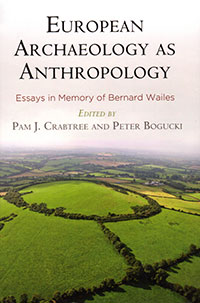
European Archaeology as Anthropology:
Essays in Memory of Bernard Wailes
Since the days of V. Gordon Childe, the study of the emergence of complex societies has been a central question in anthropological archaeology. However, archaeologists working in the Americanist tradition have drawn most of their models for the emergence of social complexity from research in the Middle East and Latin America. Bernard Wailes was a strong advocate for the importance of later prehistoric and early medieval Europe as an alternative model of sociopolitical evolution and trained generations of American archaeologists now active in European research from the Neolithic to the Middle Ages. Two centuries of excavation and research in Europe have produced one of the richest bodies of archaeological data anywhere in the world. The abundant data show that technological innovations such as metallurgy appeared very early, but urbanism and state formation are comparatively late developments. Key transformative process such as the spread of agriculture did not happen uniformly but rather at different rates in different regions.
The essays in this volume celebrate the legacy of Bernard Wailes by highlighting the contribution of the European archaeological record to our understanding of the emergence of social complexity. They provide case studies in how ancient Europe can inform anthropological archaeology. Not only do they illuminate key research topics, they also invite archaeologists working in other parts of the world to consider comparisons to ancient Europe as they construct models for cultural development for their regions.
Pam J. Crabtree is Associate Professor of Anthropology at New York University. Peter Bogucki is Associate Dean for Undergraduate Affairs at the School of Engineering and Applied Science at Princeton University.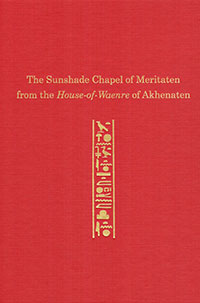
The Sunshade Chapel of Meritaten from the House-of Waenre of Akhenaten
The quartzite architectural block E16230 has been on display in the Penn Museum for 115 years. E16230 is one of the few large architectural pieces in the world surviving from the much-debated reign of the "heretic" king Akhenaten. This block is one of the most historically significant objects on display in the Egyptian galleries, yet it has never been analyzed or published. This volume addresses that glaring gap and provides for the first time a translation and discussion of the important texts on the object, along with analysis of the architectural evidence it provides.
The block is part of the once intensely ornamented façade of a solar chapel ("sunshade") dedicated to princess Meritaten, the eldest daughter of Akhenaten and Nefertiti. The large (1100 kg) block originates in a chapel that was part of a royal ceremonial palace of Akhenaten named House-of-Waenre ("the house of the Unique-one-of-Re"). Later, after demolition of the building, the block was reused in the city of Heliopolis as the base for a sphinx of king Merenptah (Dynasty 19). Subsequently the block underwent a final stage of reuse in Cairo in the Islamic Period where it was found ca. 1898 in the Mousky district of central Cairo. Because the block is such a major architectural element it provides considerable detail in the reconstruction of the essential appearance, decoration, and other aspects of the Meritaten sunshade.
The volume addresses the significance of the piece and the Meritaten sunshade in the context of Akhenaten's monumental program. Major implications emerge from the analysis of E16230 providing further evidence on the royal women during Akhenaten's reign. The book examines two possibilities for the original location of the Per-Waenre in which the Meritaten sunshade stood. It may be part of a large Amarna Period cult precinct at Heliopolis, which may, like the capital city at Tell el-Amarna, have born the wider name Akhet-Aten, "Horizon of the Aten." Alternatively it could derive from Tell el-Amarna itself, possibly belonging to a hitherto unidentified palatial complex at that site. The book is a contribution to the study of one of the most debated eras of ancient Egyptian history focused on this long-ignored treasure of the Penn Museum's Egyptian collection.
Josef Wegner is Associate Curator in the Egyptian Section at the University of Pennsylvania Museum of Archaeology and Anthropology and Associate Professor of Egyptology at the University of Pennsylvania.
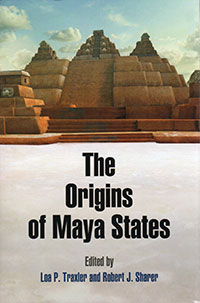
The Origins of Maya States
The Pre-Columbian Maya were organized into a series of independent kingdoms or polities rather than unified into a single state. The majority of studies of Maya states focus on the apogee of their development in the Classic period, ca. 250–850 CE. As a result, Maya states are defined according to the specific political structures that characterized Classic period lowland Maya society. The Origins of Maya States is the first study in over 30 years to examine the origins and development of these states specifically during the preceding Preclassic period, ca. 1000 BCE to 250 CE.
Attempts to understand the origins of Maya states cannot escape the limitations of archaeological data, and this is complicated by both the variability of Maya states in time and space and the interplay between internal development and external impacts. To mitigate these factors, editors Loa P. Traxler and Robert J. Sharer assemble a collection of essays that combines an examination of topical issues with regional perspectives from both the Maya area and neighboring Mesoamerican regions to highlight the role of interregional interaction in the evolution of Maya states. Topics covered include material signatures for the development of Maya states, evaluations of extant models for the emergence of Maya states, and advancement of new models based on recent archaeological data. Contributors address the development of complexity during the Preclassic era within the Maya regions of the Pacific coast, the highlands, and northern lowlands and explore Preclassic economic, social, political, and ideological systems that provide a developmental context for the origins of Maya states.
Loa P. Traxler is Director of Museum Studies and Assistant Professor of Anthropology at the University of New Mexico.
Robert J. Sharer (1940–2012) was Shoemaker Professor Emeritus of Anthropology at the University of Pennsylvania, and Curator Emeritus of the American Section at the University of Pennsylvania Museum of Archaeology and Anthropology.

The Bronze Age Towers at Bat, Sultanate of Oman:
Research by the Bat Archaeological Project, 2007–12
In the 3rd millennium BCE, the Oman Peninsula was the site of an important kingdom known in Akkadian texts as “Magan,” which traded extensively with the Indus Civilization, Southern Iran, the Persian Gulf states, and Southern Mesopotamia. Excavations have been carried out in this region since the 1970s, although the majority of studies has focused on mortuary monuments at the expense of settlement archaeology. While domestic structures of the Bronze Age have been found and are the focus of current research at Bat, most 3rd millennium BCE settlements in Oman and the UAE are defined by the presence of large, circular monuments made of mudbrick and/or stone that are traditionally called “towers.” Whether these “towers” are defensive, agricultural, political, or ritual structures has long been debated, but very few comprehensive studies of these monuments have been attempted. Between 2007 and 2012, the University of Pennsylvania Museum of Archaeology and Anthropology conducted excavations at the UNESCO World Heritage Site of Bat in the Sultanate of Oman under the direction of the late Prof. Gregory L. Possehl. The focus of these years was on the monumental stone “towers” of the 3rd millennium BCE, looking at the when, how, and why of their construction through large-scale excavation, GIS-aided survey, and the application of radiocarbon dates. This has been the most comprehensive study of non-mortuary Bronze Age monuments ever conducted on the Oman Peninsula, and the results provide new insight into the formation and function of these impressive structures that surely formed the social and political nexus of Magan’s kingdom.
Christopher P. Thornton is a Consulting Scholar of the Penn Museum and Director of the Bat Archaeological Project.
Charlotte M. Cable is a postdoctoral researcher at the University of New England (Armidale, New South Wales, Australia) and Co-director of the Bat Archaeological Project.
Gregory L. Possehl (1941–2011) was Professor Emeritus of Anthropology at the University of Pennsylvania and Curator of the Asian Section of the Penn Museum.

The Golden Age of King Midas Exhibition Catalogue
Gordion is frequently remembered as the location of an intricate knot ultimately cut by Alexander, but in antiquity it served as the center of the Phrygian kingdom that ruled much of Asia Minor during the early first millennium BCE. The site lies approximately 70 km southeast of Ankara in central Turkey, at the intersection of the great empires of the East (Assyrians, Babylonians, and Hittites) and the West (Greeks and Romans); consequently, it occupied a strategic position on nearly all trade routes that linked the Mediterranean with the Near East. The University of Pennsylvania has been excavating at Gordion since 1950, revealing a wide range of discoveries that span nearly four millennia. The vast majority of this material attests to the city’s interaction with the other great kingdoms and city states of the Near East during the Iron Age and Archaic periods (ca. 950–540 BCE), especially Assyria, Urartu, the Neo-Hittite city-states of North Syria, Persia, Lydia, and Greece, among others. Gordion is thus the ideal centerpiece for an exhibition dealing with Anatolia and its neighbors during the first millennium BCE. Through a special agreement signed between the Republic of Turkey and the University of Pennsylvania in August of 2012, Turkey has loaned the Penn Museum over 100 Phrygian artifacts from four museums in Turkey (Ankara, Gordion, Istanbul, and Antalya) for an exhibition entitled The Golden Age of King Midas. This includes the majority of the material unearthed in Tumulus MM (the “Midas Mound”, ca. 740 BCE), which was the burial site of King Midas’ father, as well as a number of objects from a series of Lydian tombs. The Turkish loan has made possible an unusually large and elaborate exhibition, which also features a disparate group of rarely seen objects from the Penn Museum’s own collection, particularly from the Ukraine, Iran, Iraq, Turkey, and Greece. With the historic King Midas (ca. 740–700 BCE) as its major theme, the exhibition encompasses the relationships between Phrygia and Lydia, Persia, Assyria, and Greece. The catalogue of the exhibition contains essays on Gordion, Phrygia, and the ancient Near East, as well as the most important objects in the exhibition.
C. Brian Rose is Pritchard Professor of Classical Studies and History of Art at the University of Pennsylvania and Curator-in-Charge of the Mediterranean Section of the University of Pennsylvania Museum of Archaeology and Anthropology.
Gareth Darbyshire is Gordion Archivist at the University of Pennsylvania Museum of Archaeology and Anthropology.

The New Chronology of the Bronze Age Settlement of Tepe Hissar, Iran
Tepe Hissar is a large Bronze Age site in northeastern Iran notable for its uninterrupted occupational history from the fifth to the second millennium B.C.E. The quantity and elaborateness of its excavated artifacts and funerary customs position the site prominently as a cultural bridge between Mesopotamia and Central Asia. To address questions of synchronic and diachronic nature relating to the changing levels of socioeconomic complexity in the region and across the greater Near East, chronological clarity is required. While Erich Schmidt's 1931-32 excavations for the Penn Museum established the historical framework at Tepe Hissar, it was Robert H. Dyson, Jr., and his team's follow-up work in 1976 that presented a stratigraphically clearer sequence for the site with associated radiocarbon dates. Until now, however, a full study of the site's ceramic assemblages has not been published. This monograph brings to final publication a stratigraphically based chronology for the Early Bronze Age settlement at Tepe Hissar. Based on a full study of the ceramic assemblages excavated from radiocarbon-dated occupational phases in 1976 by Dyson and his team, and linked to Schmidt's earlier ceramic sequence that was derived from a large corpus of grave contents, a new chronological framework for Tepe Hissar and its region is established. This clarified sequence provides ample evidence for the nature of the evolution and the abandonment of the site, and its chronological correlations on the northern Iranian plateau, situating it in time and space between Turkmenistan and Bactria on the one hand and Mesopotamia on the other.
Ayse Gürsan-Salzmann a graduate of Robert College (Istanbul) and Ball State University, earned her M.A. and Ph.D. degrees in anthropology from the University of Pennsylvania. She is a Consulting Scholar in the Mediterranean Section of the Penn Museum and the Deputy Director of the Gordion Archaeological Project.

The Sphinx That Traveled to Philadelphia
The Story of the Colossal Sphinx in the Penn Museum
Written to celebrate the centennial of the Sphinx's arrival in Philadelphia, The Sphinx That Traveled to Philadelphia tells the fascinating story of the colossal sphinx that is a highlight of the Penn Museum's Egyptian galleries and an iconic object for the Museum as a whole. The narrative covers the original excavations and archaeological history of the Sphinx, how it came to Philadelphia, and the unexpected ways in which the Sphinx's story intersects with the history of Philadelphia, the University of Pennsylvania, and the Museum just before World War I.
The book features ample illustrations—photographs, letters, newspaper stories, postcards, maps, and drawings—drawn largely from the extensive materials in the Museum Archives. Images of related artifacts in the Penn Museum's Egyptian collection and other objects from the Egyptian, Near East, and Mediterranean Sections (many not on view and some never before published), as well as pieces in museums in the United States, Europe, and Egypt, place the story of the Penn Museum Sphinx in a wider context. The writing style is informal and text is woven around the graphics that form the backbone of the narrative. The book is designed to be of interest to a wide audience of adult readers but accessible and engaging to younger readers as well.
Josef Wegner is Associate Curator in the Egyptian Section at the University of Pennsylvania Museum of Archaeology and Anthropology and Associate Professor of Egyptology at the University of Pennsylvania.
Jennifer Houser Wegner is Associate Curator in the Egyptian Section at the University of Pennsylvania Museum of Archaeology and Anthropology.
